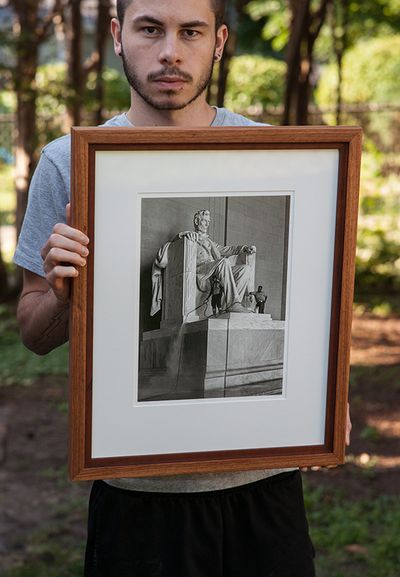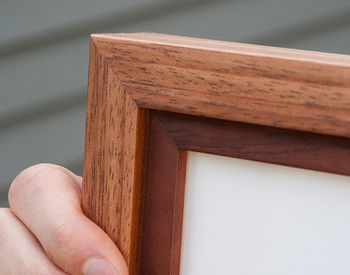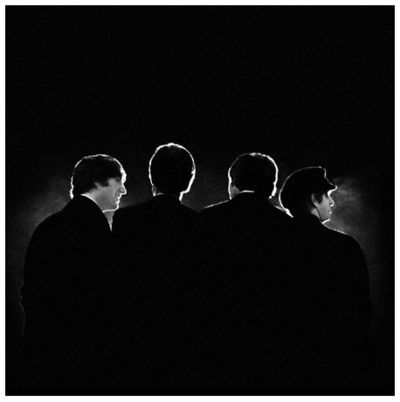So today is the last day of the Lincoln Memorial print sale. Orders close at 7:00 this evening. As you know, once we close the orders, that's it. The streamlined machine that is Cteinville* swings into action for printing and fulfillment, so no further orders are accepted. Here's how to order.
"At times 'tis folly to hasten; at other times, to delay. The wise do everything in its proper time." (Ovid)
My copy of the AP (artist's proof) came back from the framer yesterday afternoon. My pals Chris and Maria at Gallery 1 in Waukesha (no, I did not get a discount for mentioning that! I just like the place) took care of most of the decisions for me. It looks fantastic. Elegant and subdued, with rich tones. Tasteful. David's idea of what he wanted in the print ("strict formality contrasting with the two workers casually standing there") comes across very well. Hits my buttons, this one do. But then, I do love shades of gray. (Xander had to hold it at a bit of an angle to avoid reflections. The above was taken with my portrait rig, the A900 and Sony 85mm ƒ/2.8 lens [love that lens].)
Chris at Gallery 1 suggested a two-part moulding with Hawaiian koa laminate on the main part (I almost wrote "main frame" until I realized that those two words together would cause trains of thought to jump tracks in the brains of the many former and current IT guys who read this site) and an inner rim of American cherry. The framing cost $176 all in, which is more than a little rich for me for a frame, not to mention closing in on twice the cost of the print, but it looked so good I couldn't help it. In the new abode, this one might have to go upstairs rather than below ground level in the office space.
Visiting hours: Speaking of which, in my house hopefully to be, I hope to have most of the print sale prints plus a number of other goodies on display as a sort of casual gallery. I'm still planning to set up "office hours" (so to speak) in the new house. I'm thinking 2:30–4:00 p.m. Tues./Wed./Fri. (I have to limit the time to prevent too great an incursion into my working hours. I ration phone calls for the same reason. People always want me to do things—lecture, travel, teach—but they don't consider that the more of anything else I do the less I can do of this.)
We will be just a short hop off the expressway, so if you should happen to find yourself headed toward or away from Milwaukee from or toward the West, you could stop by and say hello and see some prints. Theoretically. I admit Milwaukee is on the way to almost nothing save possibly Door County. And this arrangement will not serve readers in Perth, or Hyderabad, or our sole reader in Ulaanbaator.
The last sale: Wondering how Jack's Leica S print sale went? Quite well for such a large print (the largest we've ever offered). Forty-four were sold. Jack reports that he is very happy and that his printer is very happy. And I am also very happy, and that makes three. This leaves 44 important people yet to be heard from. If you're one of them, I'm very much looking forward to hearing how you liked your print after seeing it for real.
The next sale: There'll be no print sale in August. It's our slowest month of the year, and I'll be moving (knock on wood, if all goes smoothly, etc.). After that we'll be continuing the monthly experiment until the end of this year.
Fab photo by Mike Mitchell
With the Beatles: I meant to do a whole post on this wonderful story, but a link will have to do. It's the prime example—that I know about, anyway—of unprintable older negatives being "rescued" by digital (like DD-B's was). Mike Mitchell photographed the Beatles' first concert in America, but all the negatives were underexposed and basically unprintable, so he had done nothing with them. Cut to 40+ years later. Mike had suffered through a divorce and was broke and living in a small basement. He had the old negatives scanned and printed digitally—which worked very well—and the maiden auction of the prints at Christie's grossed more than $360,000!
Now that's our kind of fairytale. Read this, it is guaranteed to cheer you up.
TOP is off tomorrow, although I'll still be adding comments. Next week: Kirk Tuck's truly epic review of the Panasonic GH4—in parts. Kirk has nearly written another novel.
Here's that link again, to the sale. Have a peaceful weekend.
Mike
* The reference is to the now defunct "Steidlville."
Original contents copyright 2014 by Michael C. Johnston and/or the bylined author. All Rights Reserved. Links in this post may be to our affiliates; sales through affiliate links may benefit this site.
(To see all the comments, click on the "Comments" link below.)
Featured Comments from:
k4kafka: "I'm a bit confused how badly under-exposed and 'unprintable' film negatives can be magically 'rescued' by the miracle of digital scanning. Can you enlighten me?"
Tech. Ed. Ctein replies: What makes underexposed negatives like this difficult or impossible to print well in the darkroom is that all the important detail is down on the toe of the characteristic curve, where the contrast is very low, the tonal separation is poor, and the graininess is horrible. The only way to get enough separation in the shadows in those sorts of negatives is to go to a really high contrast grade of paper (because those really dark tones are being printed on the shoulder of the paper curve which is also, annoyingly, very low in contrast). Then you have to do a lot of dodging and burning, and the results still look crappy because the midtones and highlights will come out very harsh. On top of that, high contrast paper exaggerates the already-bad grain. [Here is an example of how all that looks in practice. —Mike the Ed.]
In a photograph like this where the really important subject matter is the very dark workers, it means that getting a darkroom print that is satisfactory is going to be extraordinarily difficult task. Maybe not impossible, but well beyond DD-B's skill set.
Digital printing gives you three advantages right out of the gate. First, you can linearize the characteristic curve to improve contrast in the shadows without driving it through the roof in the midtones and highlights. Second, you can do local contrast enhancements and dodging and burning with much more flexibility and precision and fine detail than would be possible in the darkroom. Third, you can use noise reduction tools to reduce the problem of excessive graininess, and you can use them selectively where they are most needed.
For excruciating detail on what was done to this photograph, you should go read the article on DDB's website.
It's just as Arthur C. Clarke said: "Any sufficiently advanced technology is indistinguishable from magic."
Bruce Katz: "I have such fond memories of assisting Mike Mitchell back in the day. Long hours in the studio on F Street and out on location with our mutual friends Angie and Kevin. Mike did (does) great studio work and brilliant documentary stuff too—he has such a great, natural eye. I remember he was the official photographer for for a Papal visit to D.C.; that work was brilliant too. So glad this work came to light and that he's had such success with it."
Mike replies: Hey Bruce, what's shakin'? Long time no see.
Joe Holmes: "I hate to be the bearer of bad news, but a print of that Mike Mitchell Beatles photo will apparently now set you back anywhere from almost $7,000 to $34,000, depending on size, at this New Mexico gallery. Of course that must be very good news for Mike Mitchell."






Mike, the Lincoln Memorial print looks wonderful in that frame. A suggestion: Perhaps you should get future prints framed and show an image of the framed work on the site when the sale goes live. I liked this image, but it only seemed to exist as a JPEG until I saw this post, which really brought the image to life as a real physical object that I could put on my wall. Maybe doing this from the get-go would inspire more people to take the plunge on future print offers.
Posted by: BH | Friday, 11 July 2014 at 01:29 PM
Dear Mike,
You know, that snap of the Xander holding the framed picture does a better job of conveying the **feel** of the print, in person, than the “formal” JPEG. It looks realer to me, somehow.
As for Xander holding the picture at an angle… You could have fixed that in Photoshop, y'know. Perspective adjustments and all that [GD & R]…
Helpfully yours,
pax \ Ctein
[ Please excuse any word-salad. MacSpeech in training! ]
======================================
-- Ctein's Online Gallery http://ctein.com
-- Digital Restorations http://photo-repair.com
======================================
Posted by: ctein | Friday, 11 July 2014 at 01:35 PM
I hope that photo of the Beatles is on the list for a print sale. I would buy that one even if I have absolutely no room in my RV.
[I did approach Mike about it, through an intermediary, but he thought it was "too soon" after the Christie's sale. I should ask again though.... --Mike]
Posted by: Ed Kirkpatrick | Friday, 11 July 2014 at 02:19 PM
Am the only who dislike a glass plate over the photo print. I know that you can get them in different qualities, but there will always?, some reflection that really annoys me
Posted by: c. lund | Friday, 11 July 2014 at 07:17 PM
Hi Mike,
Just a quick note on Mirror Lake print:
Wow!
Posted by: Waren Jones | Friday, 11 July 2014 at 07:58 PM
your young man is far too somber for mid summer!
Posted by: jim woodard | Friday, 11 July 2014 at 09:17 PM
My tube with Jack's print has arrived in Melboune. But I'm resisting opening it until I can bring it to my framer - hopefully next week. With difficulty.
[Good idea to hold off. You would hate to risk damaging it after having it travel all that way. Let us know next week. --Mike]
Posted by: Michael Bearman | Friday, 11 July 2014 at 11:10 PM
As a kiwi longtime reader/lurker who is currently on a road trip from New York City to San Francisco, who convinced his family to make a detour to Rochester, NY, just so I could see the Lewis Hine exhibition at George Eastman House, I would welcome the chance for another detour to visit the sprawling TOP headquarters and pop a little something in your tip jar (you will have a tip jar, right? Tipping is rather odd for us Antipodeans, but you definitely deserve it).
[Thanks Jed, and great to hear about your photo-related detours. Isn't George Eastman's "breakfast nook" (with the stuffed elephant head) great? It's a wonderful stop.
Sadly I doubt I will be anywhere near receiving visitors by the time you pass this way--We'll be moving in late August and it will doubtless be carnage at the new place for some while before we settle in. But maybe next trip.... --Mike]
Posted by: Jed | Friday, 11 July 2014 at 11:50 PM
Alexander/Xander is far too severe in the photograph of the print.
Posted by: Bryce Lee | Saturday, 12 July 2014 at 01:34 AM
The print looks beautiful in that frame, Mike. I'd always thought a black and white print must have a black frame but that's made me think again.
BTW, in a comment to an earlier post on the same topic I mentioned a great photograph of the Lincoln Memorial taken by Joe Lootens in the late 1930s, early 1940s. For those interested, you can see it here:
http://www.theonlinedarkroom.com/2014/07/the-lincoln-memorial-abe-sparks-some.html
Posted by: Bruce Robbins | Saturday, 12 July 2014 at 04:48 AM
Regarding Ctine's comment on darkroom printing of thin negs, and his example of the Robert Kennedy photo.
To some of us oldtimers that is the way a photograph of a moment in history is supposed to look. When they are altered by digital magic to be "better" then, somehow, it is very disturbing.
[I contributed that, and I am not suggesting that that photo should be altered or changed. It is just an example of the problems of radical underexposure using traditional wet-darkroom methods, of the sort that Ctein was describing. --Mike]
Posted by: john robison | Saturday, 12 July 2014 at 09:00 AM
I have a feeling that a print sale of the Beatles photo could surpass your previous print sales.
Posted by: toto | Saturday, 12 July 2014 at 10:53 AM
may I ask what scanner everyone is getting good results with...also the sofeware used?
Posted by: Nicholas R. Von Staden | Saturday, 12 July 2014 at 01:10 PM
Xander's face grabbed my attention before the print in this post's photo. It reminded me of my son when he was that age -- so serious, yet so carefree. Probably the way I looked recently when I photographed old trains sitting on the tracks.
Posted by: darr | Saturday, 12 July 2014 at 04:03 PM
Guess what I really wanted to say was that dim light shots are supposed to look that way, grainy and high contrast. For those of us who grew up on film anyway. Of course with current technology that 'look' is no longer necessary.
Now where did I put that #5 contrast filter?
Posted by: john robison | Saturday, 12 July 2014 at 10:02 PM
I've made my share of desperately rescued under-exposed shots, but that just makes me hate them more. Well, sometimes the photos are still good, if the shot itself is good enough; but in my photos it always means either that the situation was beyond my equipment, or else that I messed up taking the picture, so I've never acquired any liking for the look.
Posted by: David Dyer-Bennet | Sunday, 13 July 2014 at 08:16 PM
I have to tell you: the presence of Xander vastly improves the overall effect conveyed by the print itself. No kidding. A great shot. Truly.
Posted by: paul richardson | Monday, 14 July 2014 at 08:21 AM
Thanks for the mention of Hyderabad :D It's great to know that we will have something to do in Wisconsin if and when we visit in the future :)
Posted by: almostinfamous | Tuesday, 15 July 2014 at 07:21 AM